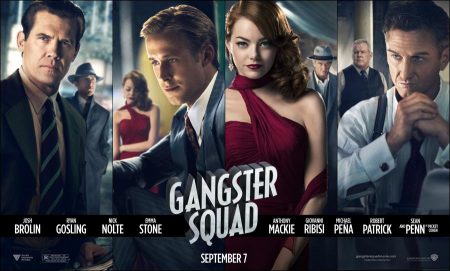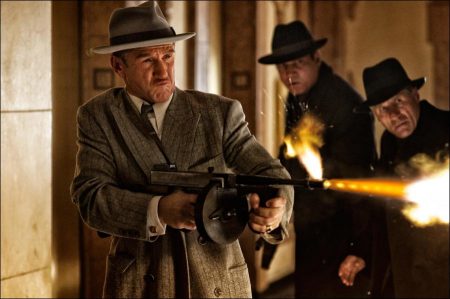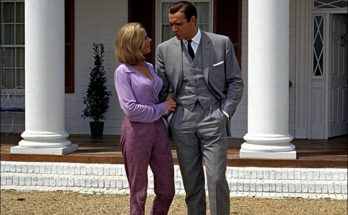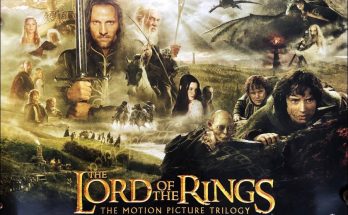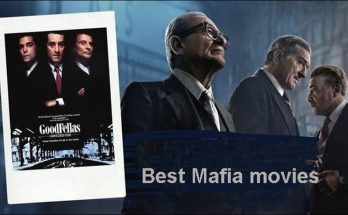Gangster Squad: Painting the town. Los Angeles, 1949. Ruthless, Brooklyn-born mob king Mickey Cohen runs the show in this town, reaping the ill-gotten gains from the drugs, the guns, the prostitutes and — if he has his way — every wire bet placed west of Chicago.
And he does it all with the protection of not only his own paid goons, but also the police and the politicians he has under his thumb. It’s enough to intimidate even the bravest, street-hardened cop… except, perhaps, for the small, secret crew of LAPD outsiders led by Sgt. John O’Mara and Sgt. Jerry Wooters, who come together to try to tear Cohen’s world apart.
Gangster Squad was filmed entirely in and around Los Angeles, utilizing a number of historic locations and transforming others to recreate memorable hotspots popular during Mickey Cohen’s reign.
“I love when movies take you back in time so completely that you feel the texture and the richness of the places, but because we also wanted this film to feel contemporary, it called for a delicate balance,” Fleischer affirms. “I was fortunate to work with some of the most talented people in the business, true artists like Dion Beebe, Maher Ahmad, Mary Zophres and Ariel Velasco Shaw. So, between the cinematography, the production design, costumes and visual effects, I think audiences will feel like they’re really back there, but will respond to the film’s modern sensibility as well.”
Discussions on the look and feel of the film began early. Cinematographer Dion Beebe recounts, “When Ruben and I first started to speak about the project, the noir reference immediately came up. As much as we both love this approach, neither of us wanted to pursue what can be a very composed genre that also tends to be quite stylized. We wanted to keep it more contemporary, despite the period. A way to bring the worlds together was by choosing to shoot digital, but combine the cameras with anamorphic lenses. This, along with a very dynamic approach to camera movement, shifted us towards a more contemporary aesthetic, but hopefully maintained a sense of the period and the genre. It was a little daunting to take the digital format and apply it to such a classic period, but it was exciting, too.”
Once the style of filming was decided upon, the filmmakers turned their attention to the practical details in order to achieve a high level of authenticity. “On a film set in the present, if you’re looking five blocks down the street, you can probably leave four of those blocks as they are,” production designer Maher Ahmad says. “But in a period film, absolutely everything needs to be adjusted or hidden or removed or added to.”
“All period movies are a challenge,” Michael Tadross attests. “Every street sign, fire hydrant, lamppost and even the line down the middle of the street was different in 1949. This was a huge undertaking for Maher’s team.”
“Because we shot outside quite a lot, and those years right after World War II had such a particular, if fleeting, look, this was a very ambitious project for me,” Ahmad relates. “Things were about to change radically with the ’50s ushering in what we now regard as Mid-Century Modern style, so I really threw myself into the visual research.”
Ahmad sifted through at least 30,000 different images, including stills he pulled from period movies as a secondary source. “Gangster films and musicals at that time tended to feature a lot of nightclubs in them, so I was able to see what the nightlife was like then,” he says.
Kevin McCormick remarks “Having lived in L.A. for a number of years, I’ve often looked at the strip malls here and there and wondered what it used to be like. During the months we were in production, I was able to see the city transformed. Starting with the script and all through the shoot, Will and Ruben and Maher and his crew really infused the locations with their love for Los Angeles, and it showed.”
An early scene in the film features a shot of one of the city’s most iconic sites: Union Station. “It’s a great place,” Ahmad remarks. So great, in fact, that although there was nothing originally written for the exterior, the production designer says that “Ruben and I discussed that we really shouldn’t pass up an outside shot of it, so he moved one of the interior scenes to the exterior.”
Inside and out, one of the film’s most important sets is Slapsy Maxie’s, the nightclub where Mickey Cohen spends his evenings dining with the public officials he keeps in his pocket, just as the real Cohen did. An empty retail space in Bellflower was transformed into the spot, and was conveniently large enough to also house part of Cohen’s business, as it was outlined in the script.
“We were originally going to build the interior of Slapsy Maxie’s on a set and shoot the exterior someplace else,” Fleischer elaborates. “But Maher found this amazing, empty storefront on a completely intact art deco block that became our hero location. As soon as Dion and I saw it, we looked at each other and knew we’d have to come up with a tracking shot that would acknowledge the terrific qualities of the site.”
“We had the exterior, the club and the bookie operation all connected together and able to be shot continuously, which was a big advantage,” Ahmad says. “It was a fun set, too, because it needed to telegraph to the audience how Cohen’s operation worked, which was on a pretty grand scale, and the space easily accomplished that.”
According to Ryan Gosling, the setting and the action were right on the money. During filming there, he overheard a conversation between the script supervisor and the fire inspector, an older gentleman. “The inspector told her he’d been at the real Slapsy Maxie’s one night and saw Mickey sitting at a table with all of his friends,” Gosling relates. “He said it was exactly like this, that Mickey used to sit right there, just like Sean was. She asked him if he remembered anything specific, and he said, ‘Yeah, he was telling a lot of jokes and none of them were funny, but everyone would laugh.'”
While Slapsy Maxie’s is Cohen’s turf, Mickey’s rival, Dragna, an Italian don who is losing control to Cohen but who still abides by Old World rules, holds court at Club Figaro. Filmed in the historic Tower Theater on Broadway in Downtown L.A., the club’s look was inspired by the Mocambo nightclub of the ’40s.
When the production came in, the theater was just a shell of its former self. “We built the bar from scratch and redid the flooring, brought in the lights, the chandeliers, ornate patterns and heavy, damask draperies,” he says. “We used deep, warm reds to create a dark, cave-like feel, in direct contrast to the green tones, sleek architecture and art deco detailing that help to evoke the hip, more contemporary vibe of Cohen’s realm at Slapsy Maxie’s.”
In addition to building sets that reflect the era, Fleischer sought to film in and around as many L.A. mainstays as possible in order to showcase the city’s history. “It was a big priority for me to try to use our landmarks,” the director attests. “Places like the Hollywood sign — which was Hollywoodland then — is one of the spots that everyone thinks of first when they think of L.A.”
To that end, historic City Hall in Downtown Los Angeles served as itself in the film, and the mayor’s conference room there was used for Chief Bill Parker’s office. The Highland Park Police Station — the oldest surviving station in the city and now the Los Angeles Police Museum — doubled as the Burbank Police Station. The Park Plaza Hotel, which dates back to 1925, neighboring MacArthur Park, and Clifton’s Cafeteria, around since the ’30s, are each featured as backdrops in pivotal scenes in the film.
A critical sequence in the story takes place in Chinatown and was filmed there over three days. Shop facades were refaced, streetlights swapped out, and colorful orange and red lanterns were added for additional flair. Fittingly, the lighting crew incorporated decorative China Balls into the lighting scheme for some of the shots.
Ascot Park stood in for Chavez Ravine, long since the site of Dodger Stadium but, in the ’40s, an area in flux, with an eye toward being redeveloped for public housing. The Mariposa Horse Stables are the site of a shootout outside a private casino run by Cohen and targeted by the squad. Catch One on West Pico was used for Coleman’s haunt, Club Alabam, and a favorite of locals in the Larchmont area, Lucy’s El Adobe Café on Melrose Avenue, became Café Caliente, a hangout for officers Kennard and Ramirez.
The squad’s field office was shot on a large plot in Sylmar, in part because it needed to appear remote, since the characters are working under the radar; the site also allowed the cameras to capture the cops driving to and from the place. John and Connie O’Mara’s modest house, located in the Mid-Wilshire district, is meant to suggest, as Ahmad puts it, “a warm, womblike, loving environment.” Conversely, Mickey Cohen’s palatial Spanish-Mediterranean-style home in the heart of Beverly Hills is everything elegant and expensive.
“The team created a world we don’t see anymore,” Dan Lin says. “Lush environments, sexy costumes… A world that still feels really glamorous and one that I think we all wish we could live in for just a moment.”
Visits: 69
